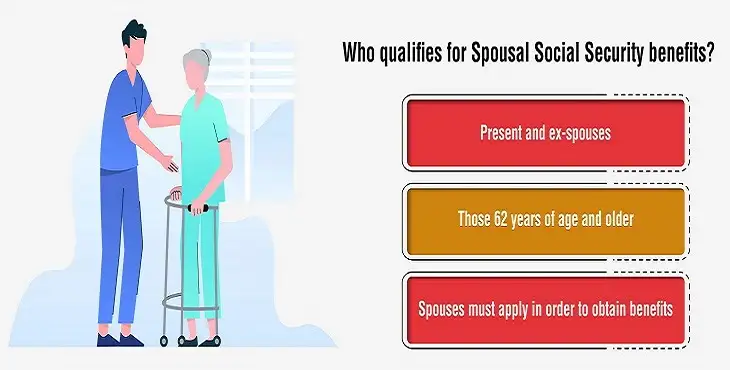Table of Contents
The benefits for your spouse can be half of the “primary insurance amount” (PIA) of the worker. However, it will entirely vary on the age of retirement of the spouse. If the spouse starts receiving the benefits before normal or full retirement age, the spouse will get reduced aid.
If the spouse is taking care of a qualifying child, the assistance is not reduced. If a spouse is at retirement age and if the Social Security benefits for the spouse are more than the spousal benefit, then retirement benefits are given. SSI spousal benefits can also be provided in certain other cases.
How to apply for SSA spousal benefits
You can apply online if you have 3 months left to reach 62 or older. Furthermore, you can also call the toll-free number 1800-772-1213 and TTY number 1-800-325-0778. You can even visit your local Social Security office.
The amount of one’s Social Security spousal benefit depends on multiple factors. These include one’s age, the maximum benefit the spouse received, and eligibility criteria for other SSA spousal benefits.
Generally, the maximum benefit claim amount for spouses is 50% of the primary beneficiary’s total benefits. However, other factors can affect this percentage.
For example, if you do not have a disabled child to care for, or you fall within some Social Security exception, it may be more difficult to claim spousal support until your working spouse claims retirement benefits. But, if you are 62 or older, you can claim spousal benefits.
Who is eligible for spousal Social Security benefits?
Generally, you are eligible for Social Security spouse benefits if you are married, divorced, or widowed, and your spouse was eligible to get benefits. You also must be married for at least one year before applying.
Many divorced spouses are eligible for ex-spousal benefits. To claim these benefits, the individuals must have been married for at least ten years, and the claiming spouse must not be entitled to a higher benefit than their ex.
What is the total spousal aid given to a surviving spouse or a divorced spouse?
The amount given to a surviving spouse or a divorced spouse is partially determined based on whether the spouse is taking care of the deceased’s children. The amount the spouse gets could be between 75% to 100% of the deceased worker’s monthly earnings.
In other cases, where a disabled worker dies while getting their disability benefits, the spouse may be able to obtain death benefits. However, SSA will first verify numerous details before providing any benefits.
If your spouse is disabled and alive, you can receive almost half of the primary insurance amount. If the children of the disabled person already get benefits and the spouse applies, the disability benefits for the spouse may be issued accordingly.
The total benefits for children and spouses can never be more than the maximum limit of family benefits, i.e. 150% of the disabled worker’s monthly Social Security disability insurance benefits. Aside from this, the SSA follows specific procedures to determine the amount of Social Security benefits issued.
How to calculate spousal Social Security Benefits
A spousal benefit is calculated as 50% of the other partner’s Primary Insurance Amount (PIA). There are some scenarios in which your spousal benefits will decrease. These include if you are already receiving retirement benefits of your own or if you apply for spousal aid before your complete retirement age.
One of the main factors involved in determining a secondary beneficiary’s Social Security benefits is retirement age. If a spouse waits until their full retirement, they may be eligible for a maximum spousal benefit. Full retirement age varies between 65 and 67 years of age, depending on the person’s birth year.
For those born after 1960, the full retirement age is 67. Some spouses still choose to claim their spousal benefits as soon as possible. However, it can significantly reduce the maximum amount that they would otherwise be entitled to. In this case, the amount of spousal benefits is reduced based on the remaining months until full retirement age.
What percentage of a husband’s spousal benefits does a spouse get?
August 2022 Statistics
| Type of Beneficiary | Number of Beneficiaries | Percentage | Total benefits (millions of dollars) | Average Monthly Benefit (Dollars) |
|---|---|---|---|---|
| Old Age and Survivors Insurance | 56,694 | 86.3 | 90,509 | 1,596.44 |
| Retirement Benefits | 50,861 | 77.4 | 82,747 | 1626.92 |
| Retired Workers | 48,123 | 73.3 | 80,499 | 1,672.76 |
| Spouses of retired workers | 2,067 | 3.1 | 1,722 | 833.02 |
| Children of retired workers | 672 | 1.0 | 527 | 785.35 |
| Survivor Benefits | 5,833 | 8.9 | 7,762 | 1,330.66 |
| Children of deceased workers | 1,981 | 3.0 | 1,942 | 980.34 |
| Widowed Mothers and Fathers | 110 | 0.2 | 125 | 1,136.66 |
| Nondisabled widow(er)s | 3,526 | 5.4 | 5,517 | 1546.76 |
| Disabled Widow(er)s | 216 | 0.3 | 177 | 819.97 |
| Parents or deceased workers | 1 | (L) | 1 | 1404.52 |
| Disability Insurance | 8,979 | 13.7 | 11,060 | 1231.80 |
| Disabled Workers | 7,728 | 11.8 | 10,528 | 1362.34 |
| Spouses of disabled workers | 93 | 0.1 | 35 | 377.35 |
| Children of disabled workers | 1,158 | 1.8 | 497 | 429.45 |
| Total | 65,673 | 100.0 | 101,570 | 1,546.59 |
100 percent disabled veteran spouse benefits
| Spouse with no children | $150 every month |
| Spouse with one child | $259 every month |
| Each additional child | $75 every month |
When can a spouse claim spousal benefits?
To qualify for spousal Social Security benefits, you must be at least 62 years of age. Further, you must be caring for a child who is entitled for benefits on the records of your spouse. The child must be younger than 16 or disabled. The spouse can also get their own benefits at 65.
For spouses who have never worked or paid Social Security taxes, spousal benefits represent the only source of retirement income.
Spouses are eligible for spousal Social Security disability benefits unless they become eligible for widower(s) benefits or retirement benefits. If the spouse is caring for a child who is disabled and collecting Social Security, the spouse may receive the dependent’s benefits even if the child is over 16 or a legal adult.
The spouse must also be at least 62 years old and unmarried. In divorce, a spouse can collect benefits from an ex even if that ex hasn’t applied for benefits of their own. If the claim is delayed until full retirement age, the divorced spouse may be eligible for 50% of the ex’s financial benefits.
How can you maximize spousal benefits?
A married couple can adopt some strategies to help them to maximize their aid. Some of the helpful strategies are:
- Strategy for late claimers
- Strategy for divorced spouses
- Strategy for widowed spouses
Strategy for late claimers: If one spouse has less or no earnings, the sensible strategy is to apply for spousal retirement benefits until age 70 to get the highest amount. If both the partners are working and their earnings are similar, the individual benefits will be more than the spousal aid. Therefore, the beneficial strategy is to postpone applying for assistance till 70 years if possible.
Strategy for divorced spouses: If you have been divorced for 2 years or more, you can still apply for benefits for your divorced spouse if your marriage lasted for at least 10 years. If a couple is on the verge of divorce and reaching retirement age, they must apply for aid before applying for a divorce.
If you have divorced multiple times, you can still apply for spousal benefits. However, you need to know your ex-spouse’s Social Security numbers and date of birth.
Strategy for widowed spouses: Widows and widowers may get complete benefits at full retirement age. They can receive reduced benefits at age 60. Even if you are married again, this will not impact your benefits. Your aid, however, may vary depending on the circumstances. Further, if your current spouse qualifies for benefits but is earning more than the former spouse, you can apply for aid based on the new spouse’s record.
Spousal Social Security Loopholes
According to the Voluntary Suspension Loophole, a married worker is permitted to voluntarily suspend their benefits at complete retirement age. This permits the spouse to receive benefits when the worker has not begun to receive their benefits.
If the worker’s spouse is getting retirement benefits, then they can only collect spousal benefits. This amendment was effective from 30th April 2016.
The Restricted Application Loophole permits individuals who are married to begin receiving the Social Security spousal benefits at full retirement age. This allows their retirement benefits to grow. It can be done through a restricted application.
This loophole follows the deemed filing provision. It means that once you file for any benefits, you file for all benefits. Deemed filing only applies to spousal benefits and not to disability or survival aid.
Want to apply for spousal Social Security benefits? Consult us Now.
We have more than 35+ years’ experience in handling disability cases. Those concerned about their eligibility for spousal Social Security benefits should contact reputable disability attorneys and schedule a free case consultation.
Spousal Disability Benefits FAQs
Client Review

